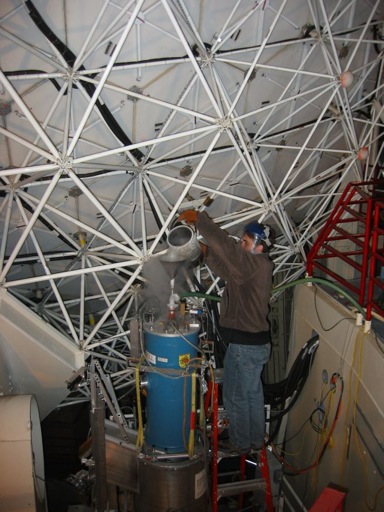
 Exploring
the Star Formation History of the Universe with ZEUS on the CSO
Exploring
the Star Formation History of the Universe with ZEUS on the CSO 
The first stars of the
Milky Way galaxy formed more than 13 billion years ago – within a
billion years of the Big Bang itself. These stars formed within
giant, but very tenuous
molecular clouds that predominantly consist of molecular hydrogen and
atomic helium, but also contained a minute trace of
heavier elements such as carbon, oxygen, and nitrogen. Though
rare, these heavy elements are the key to
enabling the formation of lower mass stars such as the Sun. As
the cloud collapses under its own self-gravity, it
will heat up as gravitational potential energy is converted into
kinetic energy of the constituent particles. Heat
causes thermal pressure which fights collapse, and indeed the collapse
will stall if the cloud can not cool.
Fortunately, the trace elements provide the cooling power to further
the collapse. Collisions within the gas excite
the low-lying rotational energy levels of molecules like CO and H2O
and the fine-structure energy levels of atoms and
ions such as C, C+, and O. These levels emit line
radiation which enables the cloud to cool, to collapse, and
ultimately to form stars.
The universe is expanding, and this expansion causes light to be
shifted to longer wavelengths (redshifted) as it travels from galaxies
in the early universe to our telescopes on Earth. The effect of
the redshift is that light emitted at a wavelength, λemitted
by a
distant galaxy, will be observed at the Earth at a longer wavelength,
λobserved. The difference between these two
wavelengths is
related to what astronomers call the redshift parameter, z by
λobserved/λemitted = 1 + z. This redshift
parameter is a measure
of the distance to the source and, since light travels at a finite
speed, it is also a measure of look-back time to the early
universe. To look at high redshift objects is to see these
galaxies as they were billions of years ago. Researchers led by
Professor Gordon Stacey at Cornell University built the
redshift (z) and Early Universe Spectrometer (ZEUS) to study star
formation at early times by detecting the fine-structure lines of C+,
O, N+, and O++ as they are redshifted
into the short submm windows
available to observers on the CSO on Mauna Kea. They are
especially
interested in observing these lines from galaxies in the redshift
interval from 1 to 3, as it is within this interval that the star
formation activity in the universe peaked. During this time – 7
to 11 billion years ago, or 2 to 6 billion years after the Big Bang –
star formation preceded at rates 10 to 30 times that of the present
epoch. It is very likely that during this time most of stars in
the Milky Way galaxy formed. It is also within this epoch that
they find “hyper-luminous” sources – galaxies with luminosities
equivalent
to the light of more than 10 trillion Suns. If stars are
producing this energy, then these sources are producing stars at a rate
thousands of times faster than the Milky Way galaxy does today.
Galaxies that produce stars at such enormous rates will consume the raw
material for making stars (interstellar gas clouds) in times that are
short (100 million years or so) compared with the age of the Universe
(13.75 billion years), so that these star formation episodes must be
punctuated, bursts of activity. Therefore, they are often termed
“starburst” galaxies.
The rest wavelength of the important cooling line of C+
is 158
µm, so that it is transmitted through the 350 and 450 µm
telluric windows for redshifts between 1 and 2. Using ZEUS on the
CSO, they made the first detection of this line C+ from the
epoch of
maximum star formation. They detected it from the hyper-luminous
starburst galaxy MIPS J142824 at z = 1.3. This was also the first
detection of this line from a source predominantly powered by star
formation in the early universe (Hailey-Dunsheath et al. 2010).
Soon afterward, they published the first survey of the
C+ line from high redshift galaxies, which at the time our
paper was
submitted, quadrupled the number of high redshift detections of this
line (Stacey et al. 2010). They detected C+ from an
additional 12 sources, and reported a solid upper limit on a
13th. Our source list is roughly evenly split into sources
powered predominantly by star formation, those powered predominantly by
accretion onto super-massive black holes (called active galactic
nuclei, AGN), and sources with mixed, or poorly determined power
sources. The C+ line is very bright. It is
usually
the brightest single line from all galaxies and within our source list
has an apparent luminosity that is typically in excess of 10 billion
Suns – nearly the entire luminosity of the Milky Way galaxy in a single
line! They find the ratio of the C+ line to
far-infrared continuum
is eight times larger in star formation dominated systems than it is in
AGN dominated systems, so that a high ratio signals a starburst.
Furthermore, they find that unlike local systems, where star formation
is
confined to regions of the order 300 light years across, starbursts
envelop galaxies in the early universe extending tens of thousands of
light-years across. The entire galaxy appears to be forming stars
at prodigious rates! If there is life on planets in these systems
what a night sky this must be!
They also have detected the O++ 88
µm line from two
starburst/AGN composite systems SMM J02399 and APM 08279 at redshifts
2.8 and 3.9 using ZEUS on the CSO (Ferkinhoff et al. 2010). These
were the first detections of this line from any
source outside the local universe. The brightness of the O++
line tells
us that there is a very young, extremely luminous (about 30 trillion
suns!) starburst in SMM J02399 dominated by stars that are at least 30
times more massive than the sun, and 200,000 times more luminous.
For APM 082790 they find the line could arise from an equally
impressive
starburst, but might also arise from the so called “narrow-line region”
(NRL) that envelops the super-massive black hole known to be at the
core of this galaxy. Here then, we begin to learn the physics of
the mass accretion onto black holes that lead to the extreme luminosity
compact energy sources known as quasars.

Figure 1. C+
158 µm line detections of redshift 1 to 2 galaxies made with ZEUS
on the CSO.

Figure 2. F ormer ZEUS graduate student Dr. Steve Hailey-Dunsheath
fills ZEUS with liquid nitrogen on the CSO
References:
Stacey et al. ApJ, 724, 957, 2010
Ferkinhoff et al. ApJ, 714, L147,
2010
Hailey-Dunsheath et al. ApJ, 714,
L162, 2010
Go back to A Digest of Recent News and
Scientific Results at the Caltech Submillimeter Observatory

 Exploring
the Star Formation History of the Universe with ZEUS on the CSO
Exploring
the Star Formation History of the Universe with ZEUS on the CSO 

 Exploring
the Star Formation History of the Universe with ZEUS on the CSO
Exploring
the Star Formation History of the Universe with ZEUS on the CSO 

